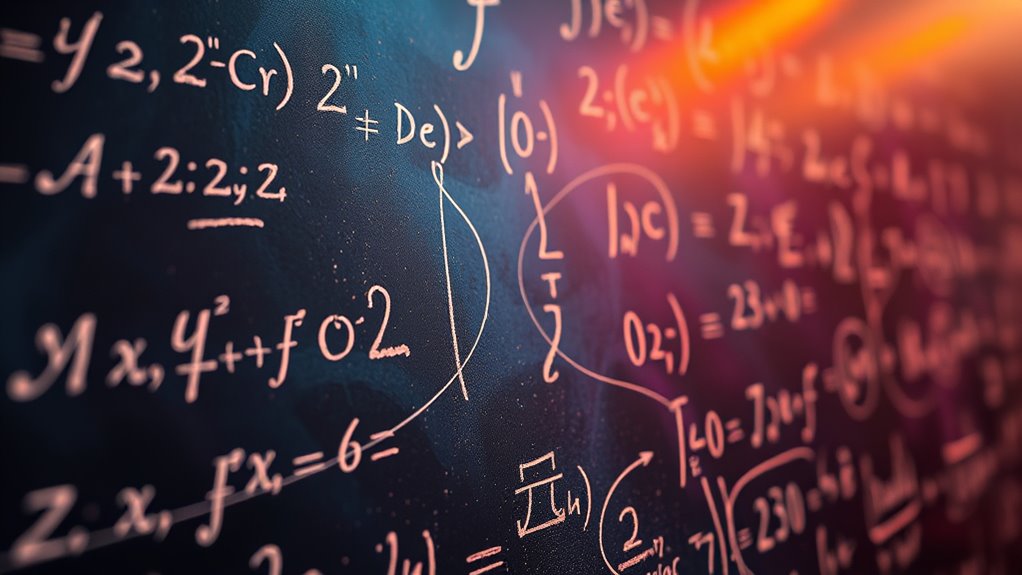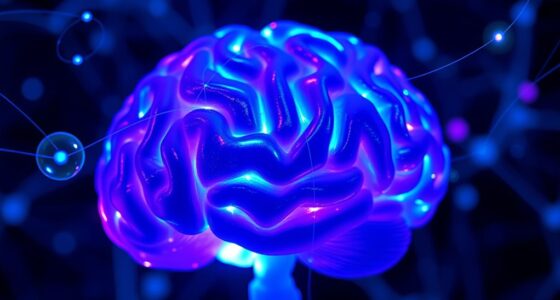Certain equations evoke emotion because they combine aesthetic harmony with deep insight, reflecting the universe’s natural order. Their symmetry, pattern, and proportion create a sense of beauty that resonates with your intuition. These formulas simplify complex ideas into elegant expressions, inspiring admiration and connection. They serve as symbols of human ingenuity and reveal hidden truths about space, time, and nature. If you want to explore how these timeless symbols stir such profound feelings, there’s more to discover ahead.
Key Takeaways
- Elegant equations embody simplicity and complexity, creating visual harmony that resonates emotionally.
- Symmetry and pattern evoke a sense of natural order and aesthetic appeal.
- Equations distill profound truths, fostering intellectual connection and admiration.
- Their balanced form reflects human creativity and universal principles, inspiring awe.
- The interplay of visual beauty and conceptual insight stirs feelings of satisfaction and wonder.

Have you ever wondered why some equations seem to captivate us with their elegance? It’s as if they hold a secret language that resonates deep within us. This sense of wonder often stems from the aesthetic harmony embedded in these formulas, a harmony that appeals to both our eyes and minds. When an equation balances simplicity with complexity, it creates a visual and intellectual elegance that feels almost poetic. You might notice how the symmetry, pattern, or proportion in such equations evokes a sense of order and beauty, mirroring the natural world’s intrinsic harmony. This aesthetic harmony isn’t just about looks; it’s about the way the components fit perfectly together, creating a seamless whole that feels both natural and profound. It’s as if the universe itself whispers through these equations, revealing its underlying structure in a way that’s both accessible and awe-inspiring. Moreover, understanding the trustworthiness of AI systems is essential for appreciating how human ingenuity is reflected in mathematical models and equations. This harmony sparks more than just admiration; it ignites a sense of connection. When you see an elegant equation, you sense an underlying truth that’s been distilled into a pure form. That’s where the idea of intellectual elegance comes into play. These equations don’t just look beautiful—they embody clarity, insight, and deep understanding. They condense complex ideas into simple, elegant expressions that reveal profound truths about nature, space, and time. The beauty lies in their ability to communicate complex concepts succinctly, making the abstract tangible. That’s why certain equations resonate so strongly—they’re not just mathematical statements but symbols of human ingenuity and insight. They evoke emotion because they reflect a fundamental order that our minds find both satisfying and inspiring. When you encounter these equations, you don’t merely see numbers and symbols; you experience a moment of connection with something greater. The allure of mathematical beauty is rooted in its capacity to blend aesthetic harmony with intellectual elegance seamlessly. It’s the harmony between form and function, simplicity and depth, that makes these formulas so compelling. They serve as bridges between logic and emotion, inviting you to explore the universe’s hidden symmetries. This interplay between visual appeal and conceptual clarity is what makes some equations timeless symbols of elegance—artful expressions of the universe’s underlying order. Ultimately, it’s this intricate dance of harmony and insight that stirs your emotions and keeps you captivated by the enduring allure of mathematical beauty.
Frequently Asked Questions
How Do Mathematicians Discover Equations With Aesthetic Appeal?
When you explore equations, you notice that aesthetic appeal often comes from visual symmetry, simplicity, and complexity. Mathematicians discover these equations by seeking patterns and elegant solutions that balance these qualities. They experiment, analyze how the parts fit together, and appreciate the harmony in the formulas. This process helps them identify equations that resonate emotionally, revealing beauty through clarity and the intricate dance between simplicity and complexity.
Can Mathematical Beauty Be Subjective or Universal?
You might wonder if mathematical beauty is subjective or universal. While cultural perception influences what people find aesthetically pleasing, many believe certain equations evoke a shared sense of harmony and elegance, pointing to aesthetic subjectivity. Ultimately, beauty in mathematics can be both personal and universal, as some find deep emotion in equations that resonate across cultures, blending individual perception with universal principles of mathematical elegance.
Are Certain Cultures More Receptive to Mathematical Elegance?
They say beauty is in the eye of the beholder, but you might wonder if certain cultures are more receptive to mathematical elegance. Cross-cultural perceptions shape aesthetic preferences, influencing how people find beauty in equations. Some cultures emphasize symmetry and simplicity, making them more receptive to elegant formulas, while others focus on practical applications. Your appreciation for mathematical beauty depends on your cultural lens, but universal patterns often resonate across borders.
How Does Mathematical Beauty Influence Scientific Discovery?
You see, mathematical beauty fuels scientific discovery by enhancing your aesthetic intuition and sharpening pattern recognition. When equations are elegant, they often reveal underlying principles more clearly, guiding your intuition and inspiring new ideas. This emotional response to beauty motivates you to explore deeper, making complex problems feel more approachable. As a result, the pursuit of elegant mathematics accelerates breakthroughs, connecting aesthetic appeal with meaningful scientific progress.
Is There a Neurological Basis for Perceiving Mathematical Beauty?
You might think there’s no neurological basis for perceiving mathematical beauty, but research shows neural correlates linked to aesthetic perception. Your brain activates specific areas when you find equations beautiful, suggesting that emotional responses are wired into your neural pathways. This connection explains why certain formulas evoke feelings of awe, indicating that your perception of mathematical beauty isn’t just subjective—it’s rooted in your brain’s complex, fascinating mechanisms.
Conclusion
When you see a perfect equation like Einstein’s E=mc², it’s more than just math — it’s a glimpse into the universe’s deepest truths. Imagine witnessing a young scientist unraveling this formula, feeling awe as they realize how it explains everything from stars to energy. That moment captures the emotional power of mathematical beauty, inspiring wonder and connection. It’s proof that these elegant equations do more than solve problems—they touch our very souls.









